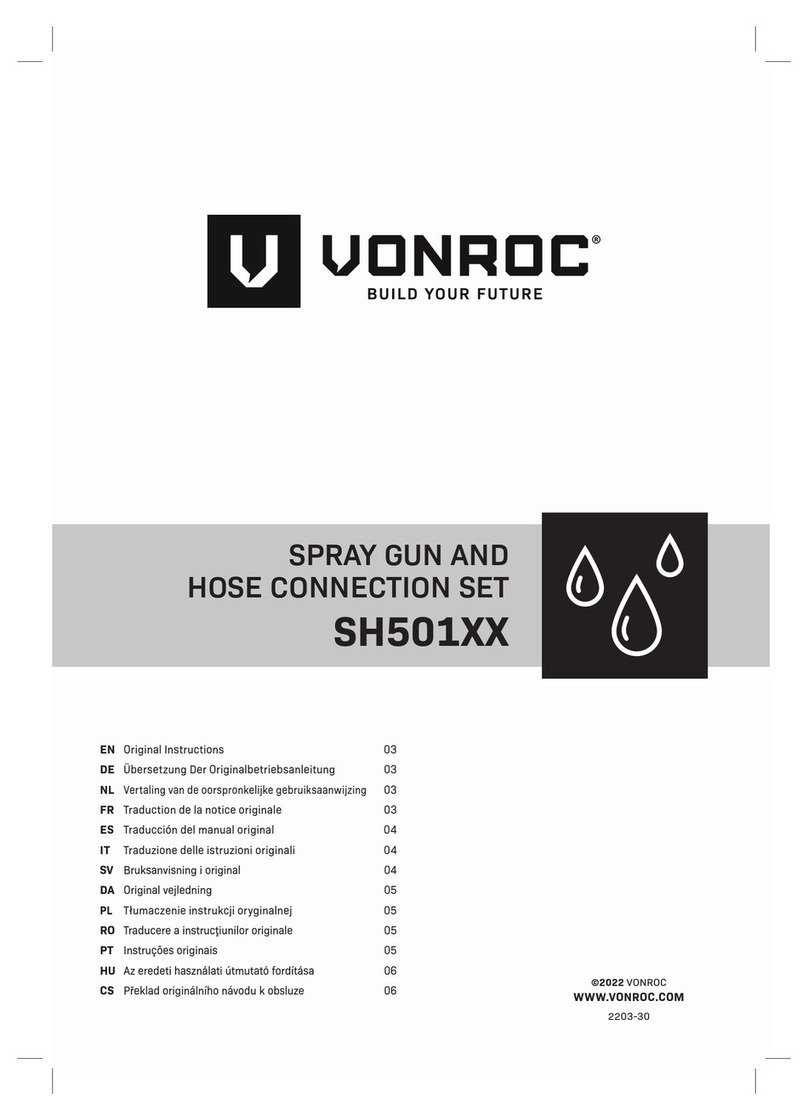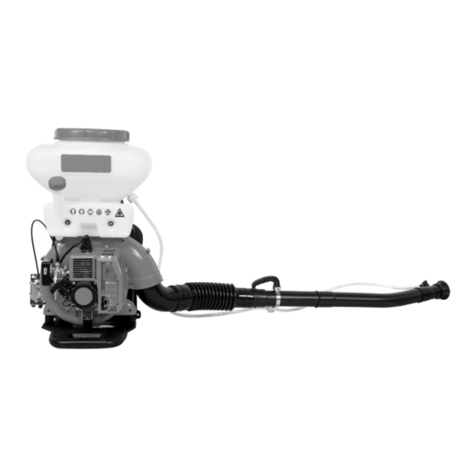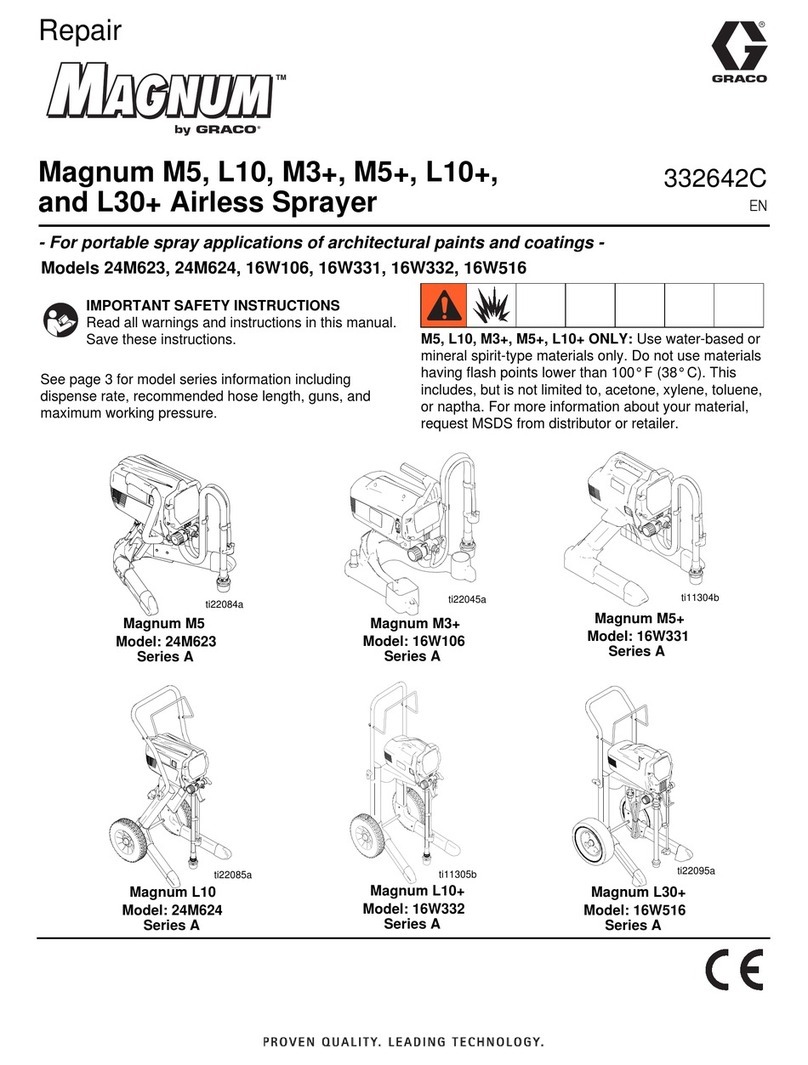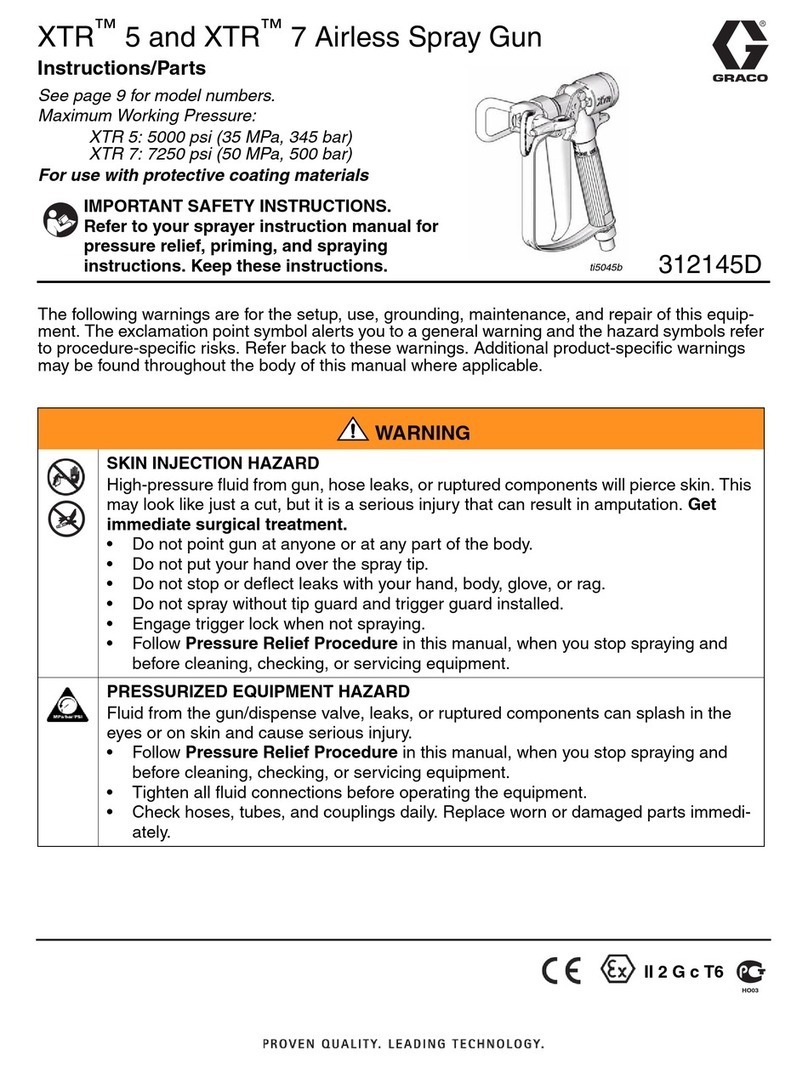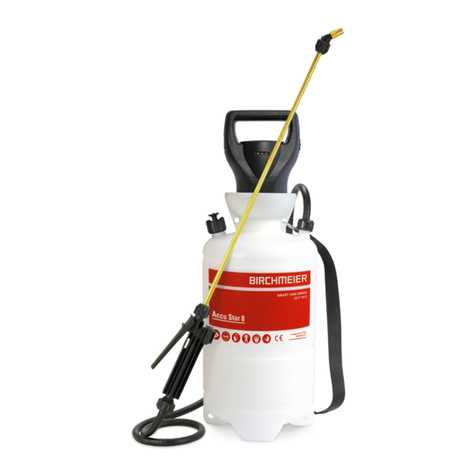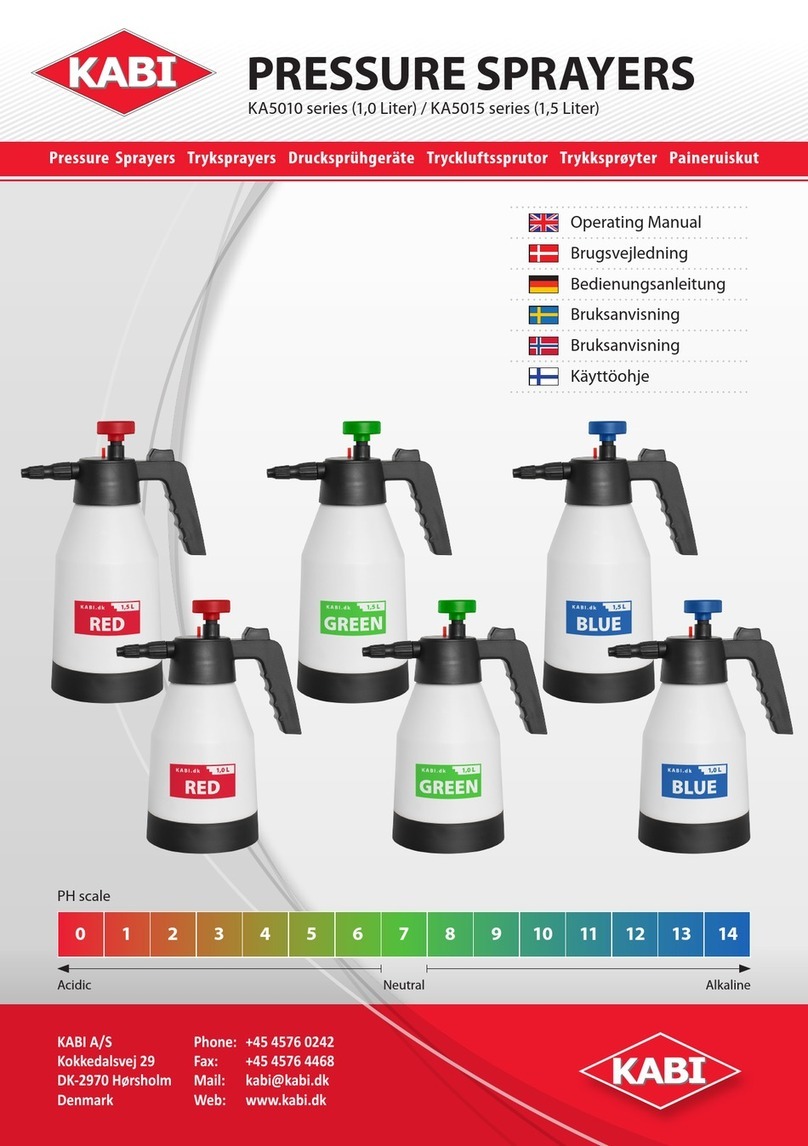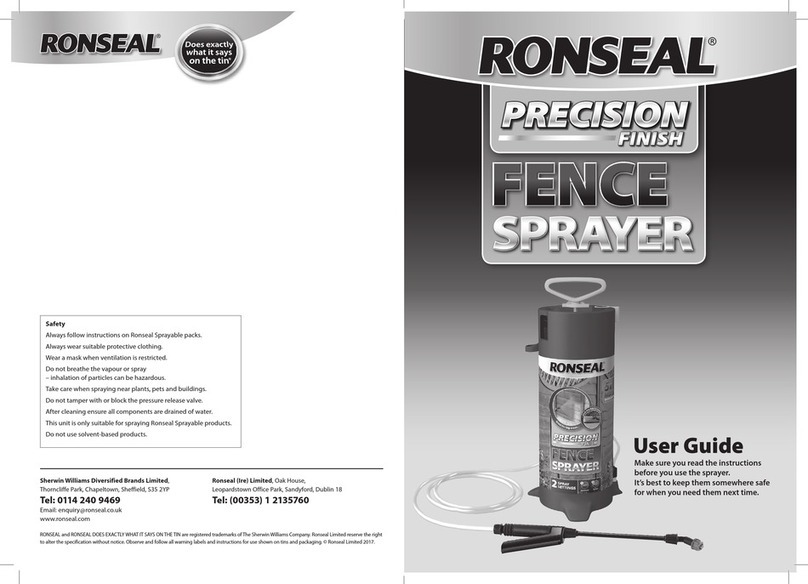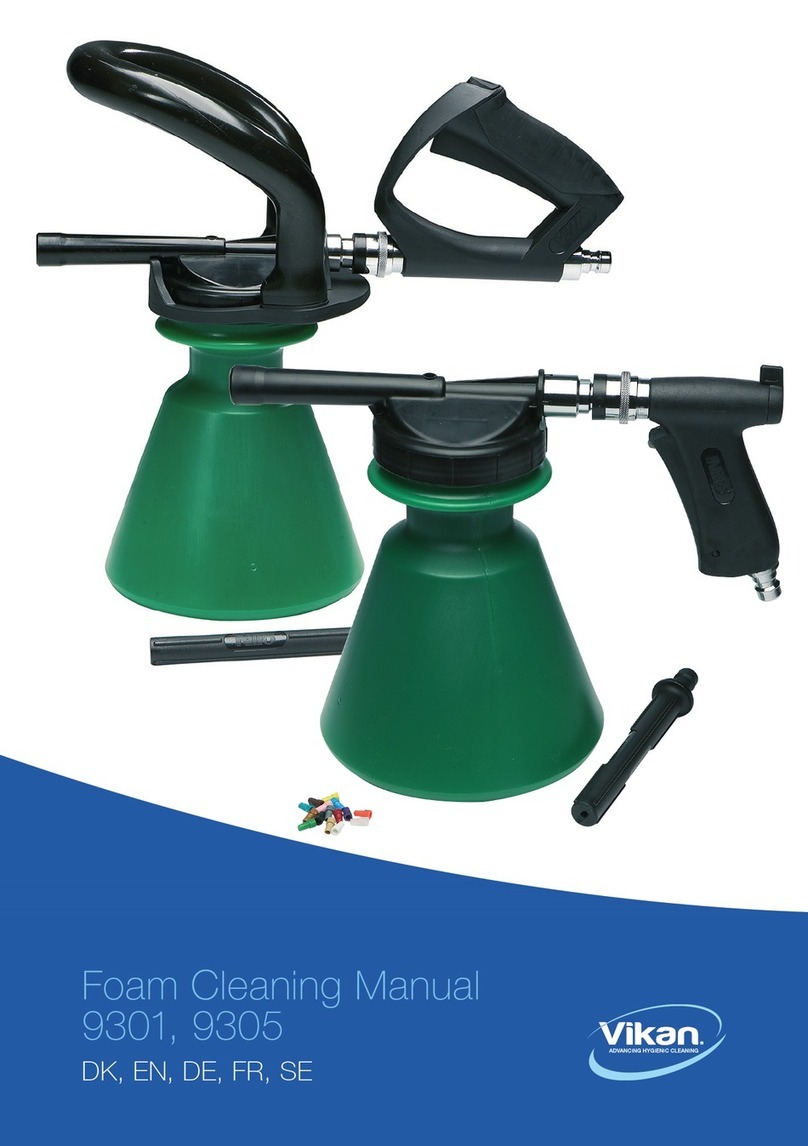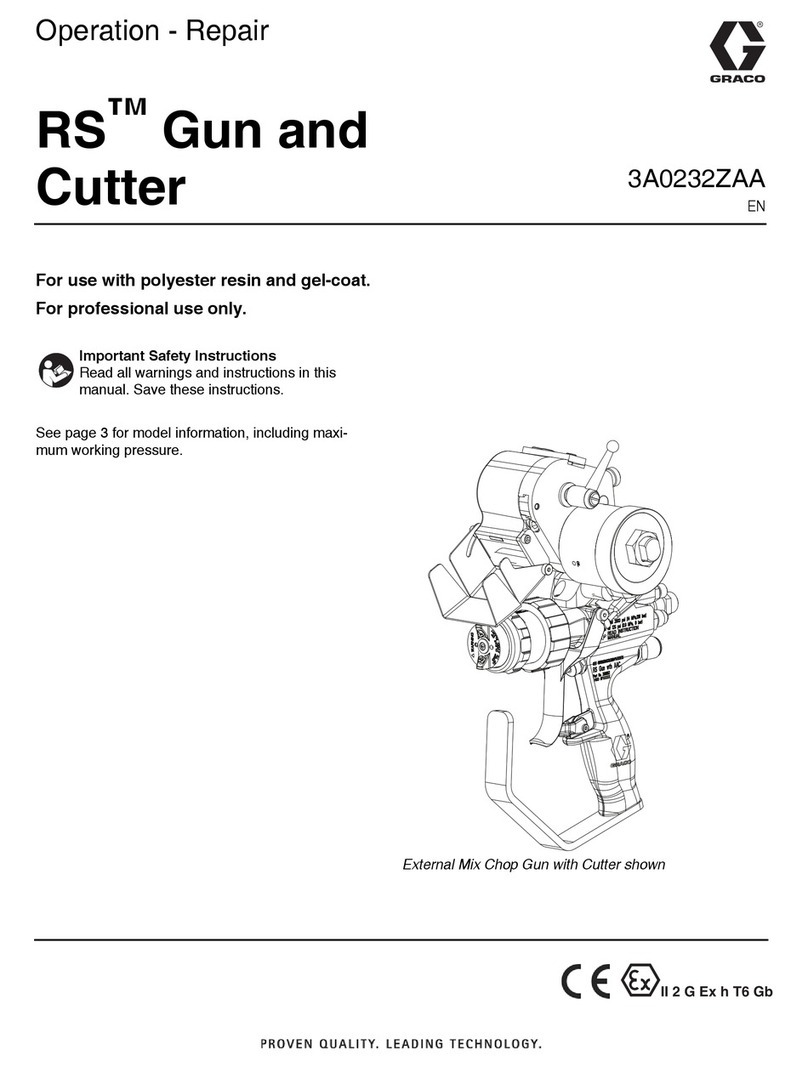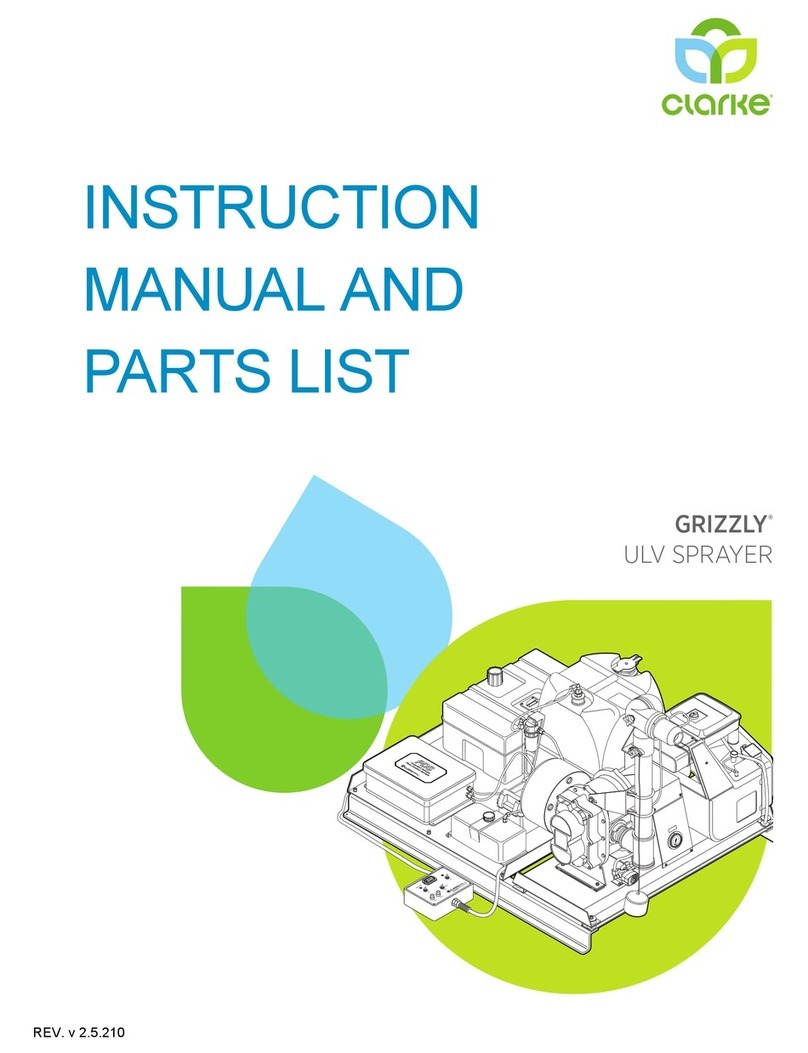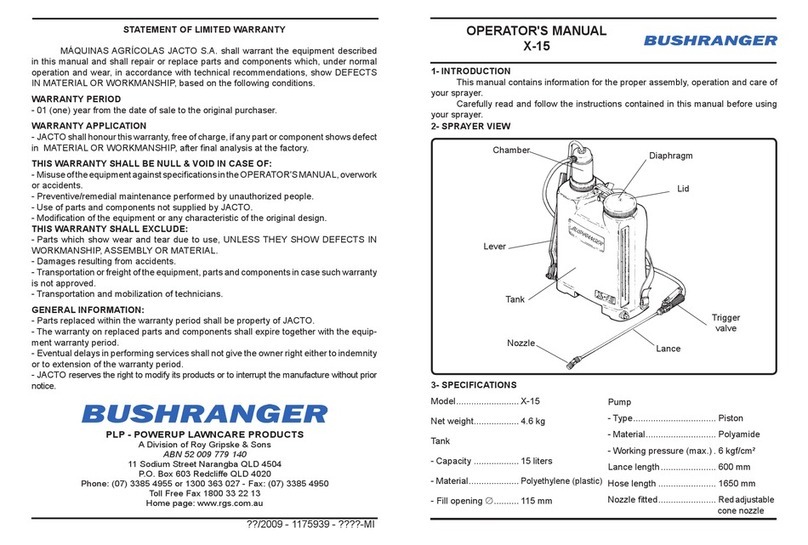GEHEIT PN 1 User manual

Geheit GmbH
Benzstraße 2
D – 72636 Frickenhausen
Germany
Phone: + 49 (0) 7022 78969021
Fax: +49 (0) 7022 78969029
www.shop.geheit.de
Spray Gun PN 1 / PN 1A
Operating Manual

Geheit GmbH
Benzstraße 2
D – 72636 Frickenhausen
FON: +49 (0)7022 78969021
FAX: +49 (0)7022 78969029
Konformitätserklärung
Declaration of conformity
Hiermit erklären wir, dass die
We declare herewiththat the
NIEDERDRUCKSPRITZPISTOLE (PN 1 / PN 1A)
HVLP SPRAY GUN (PN 1 / PN 1A)
Gemäß der folgenden Maschinenrichtlinien konstruiertund gebaut wurde:
Is constructed andproduced according to thefollowing Machinery Directives:
98/37/EG
94/9/EG
Angewendete Normen,insbesondere:
Applied standards, in particular:
DIN EN ISO 12100-1, 2004-04
DIN EN ISO 14121,2007-12
DIN EN ISO 12100-2, 2004-04
DIN EN ISO3746, 1995-12
DIN EN 1127-1, 2008-02
DIN EN 13463-1, 2002-04
DIN EN 1953, 1998-12
DIN EN ISO 13732-1, 2006-12
Hinweis: Die Niederdruckspritzpistole darfnur für ihrenbestimmungsgemässen Gebrauchtunter
Berücksichtigung der einschlägigen Sicherheitsbestimmungenverwendet werden.
The HVLP spray gunmay only be used asdirected considering the relevantsafty regulation.
Datum: 01.April.2018
(Manager director)

1
Table of Contents
1 Intended Use 2
2 Brief Description 3
3 Technical Data 4
4 Safety Notes 5
4.1 Principles; Correct Use 5
4.2 Safe Operation 6
5 Transportation and Storage 7
6 Start-Up and Operation 7
6.1 Connecting the Spray Gun 7
6.2 Paint Preparation 7
6.3 Selecting the Correct Nozzle 8
6.4 Setting the Paint Jet 9
6.5 Regulation of the Paint Quantity 9
6.6 Filling the Paint 10
7 After Paint Spraying has Finished 10
8 Care, Maintenance and Repair 10
8.1 Cleaning the Spray Gun 10
8.2 Changing the Nozzle 11
8.3 Removing the Nozzle Needle 11
8.4 Fitting the Nozzle Needle 11
8.5 Replacing the Seal Packing 12
9 Faults, Possible Causes and Remedies 13
10 Operating Instructions 14
11 Spare Parts 15
12 Special Accessories 19
12.1 Flexible joint between gun housing and paint container 20
12.2 Extension pipe for spraying points that are not readily accessible 21
13 Annex 22
© 2019 by Geheit GmbH
Printed in Germany
All rights reserved, but particularly the right of duplication, distribution and translation.
No part of this publication may be reproduced in any form (printed, photocopying,
microfilming or by any other method) without the previous written consent of Geheit
GmbH, or be stored, processed, duplicated or distributed by means of electronic
systems.

2
1 Intended Use
The ABAC Spray Gun PN 1 / PN 1A is intended for spraying paints and lacquers. The
spray gun should only be used for paints and lacquers approved by paint manufacturers
for High Volume Low Pressure (HVLP) air-spraying technique application. These are for
instance:
●Patina paints, two-component-paints, synthetic resin alkyd paints, acrylic and
dispersion paints, colour effect paints, insulation / inflammation protection paints,
sprayable wax materials.
Any use of the spray gun different from described in this manual is prohibited.
The difference between PN 1 and PN 1A ABAC Spray Guns consists in the appearance
of spray guns. The housing and individual parts of PN 1A Spray Gun are nickel plated,
the surface of PN 1 Spray Gun parts is without nickel covering. The appearance of guns
does not affect their performance and other characteristics.
Identification number of PN 1 Spray Gun is BJ 381 000 0021; PN 1A Spray Gun -
BJ 381 000 0020.
Always observe and comply with all processing instructions and safety notes provided
by material manufacturers as well the prescriptions of this operating manual.
In any case, only paints and solvents with a flash point above 21°C = 70°F may be
used for spraying!
Important ! The ABAC Spray Gun PN 1 / PN 1A must only be operated with low-
pressure blowers (from 0,2 to 0,45 bar)! It is preferable to operate the spray gun in
assembly with the original ABAC low pressure paint-spraying units.
As a part of original ABAC units, the ABAC Spray Gun PN 1 / PN 1A should work only
in combination with ABAC SG 2000,ABAC SG 2500 and ABAC SG 3001 blowers. It is
prohibited to use this spray gun together with blower units, where operating air is also
applied for motor cooling (for example, with blower ABAC SG 90). In case of their co-
use, when air supply will be stopped for spraying (by trigger release), motor overheating
and unit breakdown may occur due to air backflow and accumulation.
Ambient temperature range for equipment operation is from 0°Сto +45°С, relative
humidity must not exceed 80%. Conditions of transportation and storage see Section 5.

3
2 Brief Description
The
ABAC
Spray Gun PN
1 / PN
1
A
consists of
the spray gun itself and the screw-mounted paint
container. The air is supplied to the spray gun by
means of the connected air hose, which from the
one side is inserted into the gun handle and from
the other side is screwed into the connection pipe
of the ABAC low-pressure blower.
The air flows through the pressure hose (Fig. 3,
item 328) into the paint container where the
pressure results in a uniform flow of paint.
The trigger releases the paint contained in the
paint container for spraying through the nozzle.
The flow of air atomizes the paint at the air-head.
The amount of paint sprayed is adjustable with
the setting screw (Fig. 3, item 316).
The trigger of the PN 1 / PN 1A Spray Gun has
two positions:
●1st position: air channel is opened
●2nd position: paint channel is opened. Figure 1
Note: Keep your operating manual and attached CE declaration of conformity in a safe
place.

4
3 Technical Data
Mean sound level, DIN 45635, when connected to
SG 2000 blower 83 dB (A)
Only for paints and solvents with a flash point above 21 °C
Maximum permissible operating pressure 0,45 bar
Length approx. 180 mm
Width approx. 110 mm
Height approx. 350 mm
Weight 0.76 kg

5
4 Safety Notes
Besides this Operating Manual, and the requisite statutory safety regulations applicable in the
country and place of use, operators must also abide by the recognized codes of practice for
safe and workmanlike operation.
4.1 Principles; Correct Use
●The ABAC Spray Gun PN 1 / PN 1A is designed according to the latest technical findings
and complies with recognized safety regulations. However, if used improperly, there is a risk
of death or injury to the user or other persons, or of damage to the machine or other
property.
●The ABAC Spray Gun PN 1 / PN 1A should only be used for its intended purpose and when
it is in a perfect working order. The user must be safety conscious, fully aware of the risk,
and follow the operating instructions. Faults that could impair the operating safety of the
spray gun must be immediately remedied by an authorized person.
●The ABAC Spray Gun PN 1 / PN 1A must only be operated with low-pressure blowers (from
0,2 to 0,45 bar)! It is preferable to operate the spray gun in assembly with the original ABAC
low pressure paint-spraying units.
As a part of original ABAC units, the ABAC Spray Gun PN 1 / PN 1A should work only in
combination with ABAC SG 2000,ABAC SG 2500 and ABAC SG 3001 blowers. It is
prohibited to use this spray gun together with blower units, where operating air is also
applied for motor cooling (for example, with blower ABAC SG 90). In case of their co-use,
when air supply will be stopped for spraying (by trigger release), motor overheating and unit
breakdown may occur due to air backflow and accumulation.
Do not connect the spray gun to high-pressure blowers (from above 0,45 bar).
The equipment should never be used for any other purpose. The manufacturer or supplier is
not responsible and will not be liable for damage or injury resulting from improper use, which
shall be entirely at the user’s risk.
●Warranty obligations are valid only if the user observes the instructions and
recommendations described in this operating manual. Unauthorized changes and repair, use
for maintenance of spare parts other than original parts supplied with the product and
approved by the manufacturer or included in the spare parts list, as well operation of the
equipment under conditions other than those permitted in this manual, will void the
manufacturer’s guarantee for the ABAC Spray Gun PN 1 / PN 1A.

6
4.2 Safe Operation
●Comply with the requirements of accident prevention regulation “Processing of Coating
Materials” (e.g. in Germany VBG 23).
●All persons using the ABAC Spray Gun PN 1 / PN 1A must have read and understood this
Operating Manual, particularly the section entitled “Safety Notes”.
●Use only paints and solvents with a flash point of 21°C / 70°F or higher without additional
heating (see details on paint container).
●When working in confined spaces, these must be properly ventilated using effective
technical ventilation systems.
●The ABAC Spray Gun PN 1 / PN 1A is not splash-proof. It must not be used out of doors,
when it is raining or splashed or washed with water or immersed in liquid.
●The ABAC Spray Gun PN 1 / PN 1A must not be used in works locations subject to the
provisions of explosion prevention regulations, or on premises and in areas where there is a
risk of fire.
●Take care to ensure that there are no ignition sources in the vicinity, such as naked flames,
sparks, glowing wires, hot surfaces, lighted cigarettes etc. The distance between spray jet
exit and a possible source of ignition (even the device itself) must be at least 5 m (fire and
explosion hazard from ignitable spray mist).
●The sprayed paint emerges from the nozzle at high pressure. Never direct the spray jet at
people or animals. If the skin is injured by paint, lacquer or solvent there is a risk of infection.
Seek medical treatment immediately and inform the doctor which paint, lacquer or solvent
was used.
●Poisonous fumes may be given off during spraying (see details on the paint container). Use
a breathing mask as directed by paint manufacturer’s instructions. Keep children and other
people away from the working area.
●Keep the ABAC Spray Gun PN 1 / PN 1A in a safe place that is inaccessible to children and
unauthorized personnel. Make sure that no unauthorized personnel (particularly children)
can put the ABAC Spray Gun PN 1 / PN 1A into operation.
●Store your ABAC Spray Gun PN 1 / PN 1A in a dry ventilated room.
●For Safety reasons you should only use ABAC original accessories and ABAC original
spare parts.

7
●Always turn off the compressed air supplied by the blower before the paint container of the
ABAC Spray Gun PN 1 / PN 1A is refilled with paint.
●Repairs and maintenance works must only be carried out by authorized specialists or
by us (ABAC). Addresses of authorized firms can be obtained from us or from your
dealer upon request.
●Take care not to spray in the direction of the blower.
●Dispose of cleaning and spraying material wastes according to the instructions given by the
relevant lacquer, paint and solvent manufacturers.
5 Transportation and storage
The ABAC Spray Gun PN 1 / PN 1A is supplied in a cardboard box. To avoid damage during
transportation and storage, we recommend to use this original packaging. Store your equipment
in a dry ventilated room.
Ambient temperature range for equipment storage is from 0°Сto +45°С, relative humidity must
not exceed 80%.
6 Start-Up and Operation
6.1 Connecting the Spray Gun
●Insert the air hose of the ABAC low-pressure blower into the insulated handle of the spray
gun (see Fig.1).
6.2 Paint Preparation
●To ensure a satisfactory finish and problem-free working, particular attention must be paid to
preparation of paints and / or lacquers.
Before you begin spraying, thin paints with the solvent specified by the supplier (if
necessary). Add enough thinner so that after sufficient stirring the paint easily runs off the
stirrer. To avoid uncertainly, we recommend the use of the dipper for viscosity check,
whereby the time taken for the paint to run out shows whether the paint is still too thick and
requires further thinning. As a general rule, the run out time is 18 to 30 DIN seconds for
paints and lacquers, and 25 to 50 DIN seconds for special-effect lacquers and coating fillers
(see section 13 Annex). These values were determined at a temperature of 20°C / 70°F.
Lacquer and paint manufacturers usually specify the most favorable spraying consistency for
their products.

8
●Test the viscosity with the dipper as follows:
After thinning the paint or lacquer to spraying consistency, immerse the dipping cup until it is
full to the brim. To test, take the cup out quickly and count the number of seconds until all
the paint has flowed through the 4 mm nozzle, that is to say, up to the moment, when there
is a break in the outflow of paint. Count the seconds with your wrist watch or a stopwatch.
Where, for example, a consistency of 19 DIN seconds is required but the test result is 24
DIN seconds, thin the paint accordingly and repeat the measurement.
It is advisable to clean the dipping cup immediately after use so that it can be reused for the
next measurement.
●After thinning and stirring, sieve the paint into a clean container. To sieve the paint use a
fine-mesh paint and lacquer sieve or nylon fabric.
“Our motto is: Correct thinning and sieving is half the battle won!”
6.3 Selecting the Correct Nozzle
Before you begin spraying, you must select the right nozzle for the paint and for the object to be
sprayed (see also Section 13 “Annex”). For normal spraying work, the standard nozzle set (1.0
– 1.5 – 2.0 mm) is adequate:
·With low-viscosity paint and when spraying small objects or surface areas, use the 1.0 mm
nozzle; for larger surface areas use the 1.5 mm nozzle.
·With normal paints and lacquers and for objects with larger surface areas, select the 1.5
mm nozzle.
·When working with high-viscosity paint or when applying thick coats (for example floating
lacquering) use the 2.0 mm nozzle.
·Other nozzles sizes are available for special applications:
0,2 – 0,3 – 0.5 – 0.8 – 1.2 – 1.8 – 2.5 and 3.0 mm (special accessories).

9
6.4 Setting the Paint Jet
●To set the paint jet to a wide jet or a circular section jet (see Fig. 2) first loosen the nozzle
ring (Fig. 3, item 321), then turn air distributor of the air-head (Fig. 3, item 320) to the desired
position.
Paint jet Flat jet Circular-section jet Wide jet
Air distributor
position
Jet cross-section
(print)
Gun movement horizontal
horizontal,
vertical,
motionless
(dot-like),
circular,
diagonally
vertical
Figure 2
●The wide jet is normally used for larger surface areas, the circular section jet for edging or
spraying small and narrow areas.
●Paint consumption very largely depends on the correct paint jet setting for the type of object
to be sprayed.
6.5 Regulation of the Paint Quantity
The paint quantity is regulated with the setting screw (Fig. 3, item 316). Tightening the setting
screw limits the movement of the trigger (Fig. 3, item 304) and thus the travel of the nozzle
needle. This setting facility should be used with very fine paint applications, for example stencil
painting, patination, matt misting etc. Tightening the setting screw limits trigger travel. If this is
the case, only pull trigger until this point is reached.

10
6.6 Filling the Paint
The paint container should be filled no higher than 2 cm below the brim. Close the lid securely.
If the lid is not properly closed the gun will not work correctly.
Attention
!
Do not lay down the filled g
un but place it on a stand
or the spray gun holder, so that paint cannot flow into the
pressure hose through the small opening in the lid of the paint
container. We highly recommend always use the spray gun
holder for resting the gun on.
●The paint must first be thinned to spraying consistency in order to obtain the optimal spray
gun setting. Before starting the actual spraying work it is advisable to spray a specimen (e.g.
on cardboard or wood). Start spraying only after the result of specimen spraying is
satisfactory.
●Ensure that the adjoining areas of the object to be sprayed have been carefully covered.
7 After Paint Spraying has Finished
After you have finished spraying, turn off the ABAC low-pressure blower. Then disconnect the
air hose from the insulating handle of the ABAC Spray Gun PN 1 / PN 1A. Clean the spray gun
as described in section 8.1.
8 Care, Maintenance and Repair
Always disconnect the air hose of the ABAC lo
w
-
pressure
blower from the spray gun prior to all care, maintenance and
repair work.
Repairs must only be performed by authorized specialist firms
or by us. A list of authorized firms can be obtained from us or
your dealer.
A special after-sales service for the ABAC Spray Gun PN 1 / PN 1A is not necessary. However,
the packing seal and the lid seal must be replaced when they are worn out (see section 9).
8.1 Cleaning the Spray Gun
The spray gun should be cleaned immediately after the spraying work has been completed. The
cleaning procedure is as follows:
1) Pour out any remaining paint.
2) Rinse out the paint container thoroughly with a suitable solvent. During rinsing, operate
the trigger several times to clean the paint channels and nozzle.

11
3) Clean the brim of the container and the lid with seal carefully with a soft cloth or brush
using a suitable thinner.
On no account use sharp-edged tools as these may damage the seal and the surface of the
container.
Dried paint residues on the air-head (Fig. 3, item 320) should not be scratched off with a hard
object. Immerse the air-head into a thinner for few minutes and then remove the residual with a
brush.
Attention! After working with water-soluble paints such as acrylic paints, dispersions or binder
emulsions, the nozzle, nozzle-needle, trigger and the thread of the spring bushing (Fig.3, item
310) should be lightly oiled after cleaning.
If corrosive cleaning products are used, the spray gun components must be rinsed with clean
water immediately after cleaning and thoroughly dried to prevent corrosion.
Attention! Never immerse the complete spray gun or the lid with seal in corrosive
cleaning products, thinner or solvent. Also store no corrosive cleaning products, thinner
or solvent in the paint container. After cleaning of the spray gun do not tighten the lid so
that the seal not lose the elasticity.
If there is a leak in the cover seal of the paint container, or if it is defective, replace the seal.
8.2 Changing the Nozzle
Unscrew nozzle ring (Fig. 3, item 321), then take out air-head (Fig. 3, item 320). Change the
nozzle using nozzle spanner supplied (Fig. 3, item 322).
8.3 Removing the Nozzle Needle
Unscrew spring bushing (Fig 3, item 310) from the housing (Fig. 3, item 301), take out valve
disk (Fig. 3, item 308) and pressure spring (Fig. 3, item 309). Then unscrew setting screw
(Fig. 3, item 316) from spring bushing and push nozzle needle (Fig. 3, items 311 to 313) to rear.
In this way, the pressure spring (Fig. 3, item 314) complete with shim (Fig. 3, item 315) will be
ejected as well.
8.4 Fitting the Nozzle Needle
To fit the nozzle needle, reverse the sequence described above.
The nozzle needle is sealed by a packing (Fig. 3, item 306). The slotted screw (Fig. 3, item 307)
which engages in the thread of the nut (Fig. 3, item 305) presses the packing against the nozzle
needle. If paint emerges from the seal, tighten the slotted screw with the nozzle spanner
(remove nozzle needle). If the result is not satisfactory, renew the seal packing.

12
8.5 Replacing the Seal Packing
To replace the seal packing proceed as follows:
1) Unscrew spring bushing (Fig. 3, item 310) from spray gun housing (Fig. 3, item 301) and
remove it together with the nozzle needle (Fig. 3, items 311 to 313).
2) Withdraw the trigger (Fig. 3, item 304) sideways out of the gun housing.
3) Unscrew the slotted screw (Fig. 3, item 307) from the nut and take out the faulty packing.
4) Unscrew nozzle ring (Fig. 3, item 321) and take out air-head (Fig. 3, item 320).
5) Unscrew nozzle and push the nozzle needle forwards through the adapter
(Fig. 3, item 303).
6) Slip the new packing and the slotted screw on to the projecting nozzle needle.
7) Pull back the nozzle needle and screw the slotted screw into the nut using the nozzle
spanner.
8) After inserting the nozzle needle in its normal position, check the spray gun for leaks.

13
9 Faults, Possible Causes and Remedies
Attention! Never use hard or sharp-edged tools for cleaning!!!
Fault
Possible causes
Remedy
Paint flows into the
spray gun housing
·Packing seal of nozzle needle
either leaking or defective
·Clean the spray gun, tighten
or change nozzle needle
seal (packing)
·Paint has passed from the paint
container through the pressure
hose into the housing
·Clean the spray gun and
pressure hose, always hold
the spray gun vertical. Don’t
forget to use a flexible joint
and the spray gun stand /
holder
·Duckbill valve either improperly
installed or defective
·Clean the spray gun and
pressure hose, check
position and state of the
duckbill valve. Adjust valve
position, if necessary,
replace the valve
Individual drops appear
in the spray pattern
·Nozzle is clogged ·Clean nozzle
·Nozzle is damaged or worn out ·Replace nozzle
·Nozzle needle is damaged ·Replace nozzle needle
·Paint has incorrect spraying
consistency
·Check spraying consistency
of paint, use viscosity dipper
Paint still emerges from
the nozzle after
releasing the trigger
·Nozzle and / or nozzle needle are
/ is damaged
·Replace nozzle and / or
nozzle needle
·Setting nut (Fig.3, item 312) on
nozzle needle has gone out of
adjustment
·Unscrew the setting nut on
the nozzle needle until there
is adequate clearance

14
Störung
Mögliche Ursache
Abhilfe
Spray gun delivers no
paint or works unevenly
·Lid is not properly closed ·Carefully clean the lid, lid
seal and rim of cup and, if
necessary, replace lid seal.
·Angle-piece and/or pressure hose
are/is blocked
·Clean angle-piece and
pressure hose
·Nozzle is blocked ·Clean/change nozzle
Wide jet uneven ·Side holes in air-head are clogged ·Clean air-head
Paint jet sprays to one
side
·Paint has accumulated on the
outside of the nozzle
·Clean the nozzle
·Nozzle is not tightly seated ·Tighten the nozzle
·Holes in the air-head are clogged ·Clean the air-head
10 Operating Instructions
Depending on actual use and location of the equipment, users must issue an operating
instruction, based on this manual and in the language of their employees, to define further
details for the safe operation of the ABAC Spray Gun PN 1 / PN 1A. This operating instruction
is to be displayed in a suitable public place at the workplace and to be read and observed by all
employees.

15
11 Spare Parts
For safety reasons you
should only use
ABAC
original accessories
and ABAC original spare parts.
Spare parts are available from your ABAC specialist dealer or direct from us.
For speedy and efficient ordering of spare parts we require the following details:
·Identification number and designation of the spare part
·Quantity of spare parts required
·Address

16
Spare Parts List for ABAC PN 1 Spray Gun (Identification number BJ 381 000 0021) (Figure 3)
Fig. No. Quantity Designation Ident Number
301 1 Housing HE 381 100 00 02
302 1 Insulating Handle HE 300 166 03 30
303 1 Nozzle Adapter HE 300 161 15 14
304 1 Trigger B0 381 100 00 12
305 1 Hexagonal nut B0 300 161 44 11
306 1 Seal packing HE 300 161 12 00
307 1 Slotted screw B0 300 161 62 01
308 1 Valve disk HE 381 100 00 30
309 1 Pressure spring H5 970 780 01 01
310 1 Spring bushing HE 381 100 00 40
311 1 Nozzle needle HE 381 100 00 20
312 1 Hexagonal nut, self-locking H5 808 512 00 00
313 1 Spring plate HE 311 162 61 00
311-313 1 Complete nozzle needle assembly BJ 000 971 06 00
314 1 Pressure spring H5 970 560 01 01
315 1 Shim H5 810 371 00 00
316 1 Setting screw HE 300 161 14 01
317 1 1.0 mm diameter nozzle HE 300 161 20 22
318 1 1.5 mm diameter nozze HE 300 161 20 32
319 1 2.0 mm diameter nozzle HE 300 161 20 42
320 1 Complete air-head assembly
1 Flow sleeve HE 300 161 17 30
1 Air distributor HE 300 161 18 25
321 1 Nozzle ring B0 300 161 19 06
322 1 Nozze spanner B0 300 162 51 04
323 1 Adapter HE 300 161 31 10
324 1 O – Ring 14 x 18 mm, pack with 5 pieces H5 108 160 51 76
325 1 Aluminium paint container without lid B0 300 161 70 03
326 1 Aluminium lid with seal:
1 Aluminium lid HE 300 161 75 02
1 Seal, pack with 5 pieces HE 300 161 76 02
327 1 Angle piece HE 300 161 77 02
328 1 Pressure air-hose 8x260 mm BJ 000 991 95 04
329 1 Duckbill valve, pack with 5 pieces AB36836

17
Spare Parts List for ABAC PN 1A Spray Gun (Identification number BJ 381 000 0020) (Figure 3)
Fig. No. Quantity Designation Ident Number
301 1 Housing (nickel plated) HE 381 100 00 01
302 1 Insulating Handle HE 300 166 03 30
303 1 Nozzle Adapter HE 300 161 15 14
304 1 Trigger (nickel plated) B0 381 100 00 12
305 1 Hexagonal nut B0 300 161 44 11
306 1 Seal packing, bag with 5 pieces HE 300 161 12 00
307 1 Slotted screw B0 300 161 62 01
308 1 Valve disk HE 381 100 00 30
309 1 Pressure spring H5 970 780 01 01
310 1 Spring bushing HE 381 100 00 40
311 1 Nozzle needle HE 381 100 00 20
312 1 Hexagonal nut, self-locking H5 808 512 00 00
313 1 Spring plate HE 311 162 61 00
311-313 1 Complete nozzle needle assembly BJ 000 971 06 00
314 1 Pressure spring H5 970 560 01 01
315 1 Shim H5 810 371 00 00
316 1 Setting screw HE 300 161 14 01
317 1 1.0 mm diameter nozzle HE 300 161 20 22
318 1 1.5 mm diameter nozze HE 300 161 20 32
319 1 2.0 mm diameter nozzle HE 300 161 20 42
320 1 Complete air-head assembly (nickel plated) BJ 000 971 02 00
1 Flow sleeve HE 300 161 17 30
1 Air distributor (nickel plated) HE 300 161 18 26
321 1 Nozzle ring B0 300 161 19 06
322 1 Nozze spanner B0 300 162 51 04
323 1 Adapter HE 300 161 31 10
324 1 O – Ring 14 x 18 mm, pack with 5 pieces H5 108 160 51 76
325 1 Aluminium paint without lid B0 300 161 70 03
326 1 Aluminium lid with seal:
1 Aluminium lid HE 300 161 75 02
1 Seal, pack with 5 pieces HE 300 161 76 02
327 1 Angle piece HE 300 161 77 02
328 1 Pressure air-hose 8x260 mm BJ 000 991 95 04
329 1 Duckbill valve, pack with 5 pieces AB36836

Figure 3
18
This manual suits for next models
1
Table of contents
